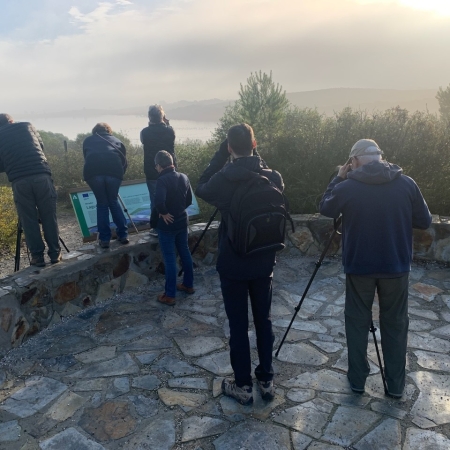
Laguna de Medina
Our first outing of the year took place on the 11th January, to Laguna de Medina to view wetland birds.
The morning started with a breakfast stop at Venta La Parada, where we were greeted by a noisy flock of Spotless Starlings and two White Storks on a lamppost that watched as cars parked below. Conditions had grown increasingly misty as we drove north but on arrival at the Laguna de Medina, the mist was thin enough to allow views of the birds. There was no wind and the water was flat calm.
The lake had dried out due to drought but following plenty of autumn rain, it had refilled, presumably without the introduced carp that had been the scourge of the submerged vegetation that wildfowl rely on. It was full of birds. A flock of one or two hundred Greater Flamingos sat in the lake, surrounded by huge numbers of Black-headed, Lesser Black-backed and Mediterranean Gulls. There were plenty of wildfowl too, with large flocks of Eurasian Coot typical of this site. Surprisingly, the most abundant duck was Red-crested Pochard. There were hundreds of birds, the beautiful males showing very well. Also numerous was Common Pochard.
Other duck seen were Mallard, Gadwall, Green-winged Teal and Northern Pintail, with only two each of the latter two species. Two or three Tufted Duck were present, as was a male bird that seemed to be a hybrid between Ring-necked Duck and another Aythya species. Grebes were represented only by parties of Black-necked Grebes. A female Marsh Harrier would drift over the lake occasionally, putting many of the birds up. The stillness of the morning allowed us to appreciate the cacophony of calls emanating from the lake and the mist created an atmosphere in which the beauty of the entire experience trumped any particular bird sighting.
We had begun by watching from the two viewing platforms to the north of the lake. We eventually turned and headed to the main path along the lake’s southern edge, taking in the bird life of the surrounding vegetation. Fruiting shrubs were teeming with Eurasian Blackcaps, many Song Thrushes and a few Redwings. A few European Stonechats sallied from the top of the relatively few reeds that now remain. Two small flocks of Spanish Sparrows were also present, as was an assortment of finches. One or two Eurasian Penduline Tits called from the tamarisk thicket along the lake shore.
Once at the end of the path, we made our way into the hide, from which we watched an assortment of the waterbirds we had seen elsewhere. Wading birds were largely absent, but a Common Snipe flew over the lake. In the hide, it became evident how well prepared some of our members turn up for even fairly short outings. Food and thermos flasks were immediately out, and one attendee had even baked rock buns for everyone. They were gratefully wolfed down, and very delicious they were too!
From Laguna de Medina, we decided to drive back via Algeciras to check for a Pacific Diver that had been sighted a day earlier, sadly without success. However, the mist had begun to clear by the time we drove down and we had sightings of birds of prey that had eluded us earlier, such as Eurasian Griffon, Eurasian Sparrowhawk, Red Kite, Black-winged Kite and a first winter Spanish Eagle.
The outing was an excellent start to our 2025 calendar of activities. We thank Andrew Fortuna for leading it, and all those who attended it.



